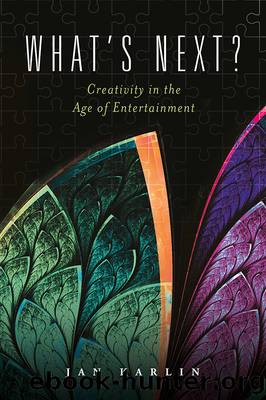What's Next?: Creativity in the Age of Entertainment by Jan Karlin

Author:Jan Karlin [Karlin, Jan]
Language: eng
Format: epub
Tags: art, General, Biography & Autobiography, Personal Memoirs, music, Performing Arts
ISBN: 9781543907032
Google: cWPWtAEACAAJ
Publisher: BookBaby
Published: 2017-08-19T23:45:10.855915+00:00
For the public benefit
American society has turned toward the nonprofit world to solve many of its problems. The Red Cross provides disaster relief, poverty is âfoughtâ by groups such as Oxfam International, and Mothers Against Drunk Driving wages the war on drunk driving. Nonprofits include think tanks, political action committees, social service agencies, and finally, arts organizations.
âNonprofitâ is poor terminology. It immediately places a value judgment on whatever the organization is addressing; it is not for profit and therefore not as valuable as something done for profit. I prefer the term âfor the public benefitâ as a better definition. In a society where money drives ideas, nonprofits are viewed as necessary to our society, determined as a public charity by the IRS, but lack the same respect level as businesses. This is despite multi-million dollar budgets, MBA programs in nonprofit management and huge corporate-style infrastructures.
An inspiring fundraising professional, Susan Scribner, developed the Vietnam War bracelet in the 1960s. She has led many workshops on nonprofit development. In the first one we attended, she had a room filled with the best of the nonprofit world: Red Cross, MADD, poverty center, senior services, rape crisis center, and many others. We were the only arts organization represented in the room. After having everyone announce their organization, Susan asked which organization they should view as significant competition.
We looked around the room at the representatives of inspiring organizations. Certainly it should be Mothers Against Drunk Driving, or the Vietnam Veterans, or perhaps the poverty center. There were many compelling groups able to access funding.
Susan surprised everyone in the room by pointing at us â Southwest Chamber Music! She said the biggest competition was the arts organization.
Her point was that every other organization in the room would gladly go out of business if their problem could be solved. We all would want to end poverty, have governments provide emergency services around the world, and extinguish drunk driving. At the end of the day, she said, the arts group will still be standing because it is what people need to inspire them at the end of the workday.
Whether you agree with Susan or not, it really shook us up. It gave value for the first time to our fledgling idea of presenting artistic and educational events in our community. It made us feel that our nonprofit idea, a public charity by IRS determination, was in fact something important and necessary.
In valuing creativity and its manifestations in culture, we need to accept its importance. Currently, a critical discussion of cultural value is happening throughout academia as universities weigh keeping traditional humanities departments despite few student majors. Adam Gopnik writes in the New Yorker
Why should English majors exist? Well, there really are no whys to such things, anymore than there are to why we wear clothes or paint good pictures or live in more than hovels and huts or send flowers to our beloved on their birthday. No sane person proposes or has ever proposed an entirely utilitarian, production-oriented view of human purpose.
Download
This site does not store any files on its server. We only index and link to content provided by other sites. Please contact the content providers to delete copyright contents if any and email us, we'll remove relevant links or contents immediately.
Kathy Andrews Collection by Kathy Andrews(11706)
The remains of the day by Kazuo Ishiguro(8787)
Paper Towns by Green John(5064)
Spare by Prince Harry The Duke of Sussex(5053)
The Body: A Guide for Occupants by Bill Bryson(4951)
Industrial Automation from Scratch: A hands-on guide to using sensors, actuators, PLCs, HMIs, and SCADA to automate industrial processes by Olushola Akande(4912)
Machine Learning at Scale with H2O by Gregory Keys | David Whiting(4103)
Be in a Treehouse by Pete Nelson(3923)
Never by Ken Follett(3761)
Harry Potter and the Goblet Of Fire by J.K. Rowling(3758)
Goodbye Paradise(3709)
Into Thin Air by Jon Krakauer(3288)
The Remains of the Day by Kazuo Ishiguro(3279)
The Cellar by Natasha Preston(3241)
The Genius of Japanese Carpentry by Azby Brown(3208)
Fairy Tale by Stephen King(3192)
120 Days of Sodom by Marquis de Sade(3160)
The Man Who Died Twice by Richard Osman(2977)
Drawing Shortcuts: Developing Quick Drawing Skills Using Today's Technology by Leggitt Jim(2974)
